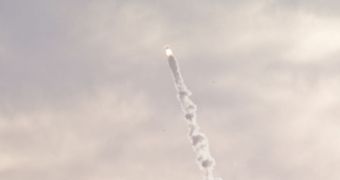Officials at NASA announce the successful completion of the first test firing of the Launch Abort System (LAS) that will go on the new Orion space capsule. Though the spacecraft has been stripped down to an unmanned escape pod for the International Space Station (ISS), the emergency system is still very important, and managers at the American space agency decided to go on and perform its due assessment. The tests began at 7 am MDT yesterday, May 6, at the US Army's White Sands Missile Range (WSMR), located near Las Cruces, in New Mexico.
After launch, the Orion capsule flew for a short while, and then the LAS was activated. The Orion capsule was successfully ejected from the tower-like structure, and managed to deploy its three parachutes just in time. It landed safely about a mile away from the original launch site, just 135 seconds after taking off. Even if this particular escape mechanism doesn't make it on the final version of Orion, the data collected yesterday will be of tremendous use to engineers seeking to develop similar mechanisms for future space missions, NASA reports.
“Through hard work and incredible dedication over the past several years, the Orion Pad Abort 1 team has successfully tested the first US designed abort system since Apollo. This system is much more advanced in capability and technology than any abort system designed in the past. NASA strives to make human spaceflight as safe as possible, and what we learned here today will greatly contribute to that goal,” explains the Exploration Systems Mission Directorate associate administrator Doug Cooke, from the NASA Headquarters, in Washington DC.
“The test involved three motors. An abort motor produced a momentary half-million pounds of thrust to propel the crew module away from the pad. It burned for approximately six seconds, with the highest impulse in the first 2.5 seconds. The crew module reached a speed of approximately 445 mph in the first three seconds, with a maximum velocity of 539 mph, in its upward trajectory to about 1.2 miles high. The attitude control motor fired simultaneously with the abort motor and steered the vehicle using eight thrusters producing up to 7,000 pounds of thrust. It provided adjustable thrust to keep the crew module on a controlled flight path and reorient the vehicle as the abort system burned out,” NASA experts write in a press release.

 14 DAY TRIAL //
14 DAY TRIAL //